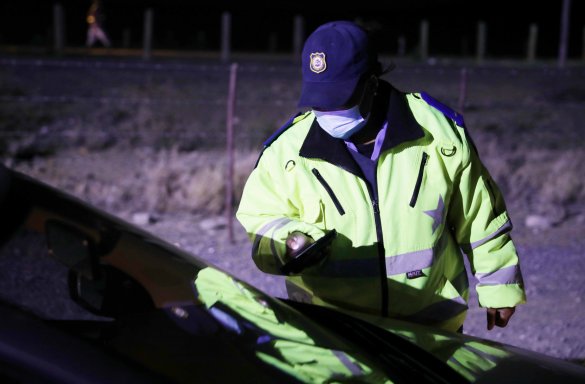Results of Provincial Traffic Services traffic operations: 13 to 19 September 2021
Western Cape Provincial Traffic Services implemented a total of 170 integrated roadblocks, vehicle check point and speed control operations across the province in the week of 13 to 19 September 2021, and 21 078 vehicles were stopped and checked.
A total of 116 speeding offences were recorded and 2 737 fines were issued for various traffic violations ranging from driver to vehicle fitness in the total amount of R2 786 900.
Eleven vehicles were impounded and 35 were discontinued for unroadworthiness.
The highest speeds recorded were as follows:
- 161 km/h in a 120 km/h zone
- 134 km/h in a 100 km/h zone
- 119 km/h in a 80 km/h zone
- 94 km/h in a 60 km/h zone
Disaster Management Act
A total of eight charges were laid under the Disaster Management Act and fines to the total value of R14 000 were issued.
National Road Traffic Act, Criminal Procedure Act, and Disaster Management Act regulations
A total of 39 arrests were made for the following offences:
- 13 x driving under the influence of alcohol
- 1 x speeding
- 7 x reckless and negligent driving
- 4 x goods overloading
- 7 x possession of fraudulent documentation
- 1 x possession of stolen vehicle
- 1 x riotous behaviour
- 1 x possession of illegal narcotics
- 1 x possession of abalone
- 1 x bribery
- 1 x failure to furnish information
- 1 x uttering or using a fraudulent operating licence or permit
Fatalities recorded between 13 and 19 September 2021
A total of 18 crashes occurred in the reporting period, and 22 fatalities were recorded:
- 1 x drivers
- 2 x motor-cyclists
- 3 x passengers
- 16 x pedestrians
Seatbelts save lives
“Always buckle up, in every seat, even on the shortest trip”, says Vigie Chetty, Acting Director: Traffic Law Enforcement. “Drivers are responsible for ensuring that all passengers are buckled up. Adults are responsible for buckling up children. All small children must be secured in an age-appropriate harness.”
A seatbelt is a safety harness designed to protect the driver and passengers of a vehicle against high-impact movements that may result from a collision or sudden stop. A seatbelt is designed to stretch at a controlled rate to absorb crash energy and to slow down an occupant’s deceleration. Seatbelts should be worn in both the front and the back seats. Occupants should make sure that their seatbelts are worn across the chest (as close as possible, but still comfortable), across the hips (not across the stomach), and they must make sure they hear the click as the seatbelt closes securely.
The impact forces of crashes on people are massive, and they are much more serious for people not wearing seatbelts. If a vehicle travelling at only 60 km/h is involved in a crash, the impact on a 55 kg person wearing a seatbelt is like being hit with a weight of 3 800 kg. Without a seatbelt, the impact force on the same person is 19 500 kg – five times worse! If the same vehicle is travelling at 90 km/h, the impact force on the same 55 kg person will over 8 700 kg with a seatbelt, and 43 800 kg without a seatbelt. (Source: https://www.omnicalculator.com/physics/car-crash-force).
Seatbelts reduce the likelihood and severity of injury in a traffic collision by stopping vehicle occupants from hitting hard elements inside a vehicle. They also reduce the risk that an occupant will be thrown out of the vehicle in a crash. In a crash, a person who is not wearing a seatbelt becomes a projectile inside the vehicle, often killing other occupants, including those who are buckled up. Children who are not buckled up can be killed or seriously injured, even in low-speed collisions.
Never drink and drive. Never drink and walk near a road. If you have been drinking, make other arrangements to get home. If you are stopped by a traffic law enforcement officer and the officer suspects that you are over the legal limit, you will be arrested. If you are convicted of driving under the influence of alcohol, you will have a criminal record.
If you drive a public transport vehicle, be extra careful throughout your journey. Make sure your vehicle is roadworthy and that your operating licence is in order. Ensure that you and all occupants are wearing a mask over their noses and mouths, and are sanitising regularly. Stay off the road during the curfew hours between 23:00 and 04:00.
Observe passenger limits – 100% of licensed carrying capacity for journeys shorter than 200 km, and 70% of carrying capacity for journeys of more than 200 km. Make sure the windows are always at least 5 cm open on both sides of your vehicle.
If you drive a long-distance heavy motor vehicle, make it a regular habit to stop and rest. It is also important to prepare yourself mentally and physically for the long road ahead by resting before trips, practising safe health protocols, eating well, hydrating yourself throughout the journey with water, and remaining vigilant about the risk of criminal activity.
#AlwaysBuckleUp #SeatbeltsSaveLives. For more information, see Safely Home on Facebook and on Twitter @WCGovSafelyHome.

